President Scott's 2020 State of the University Address
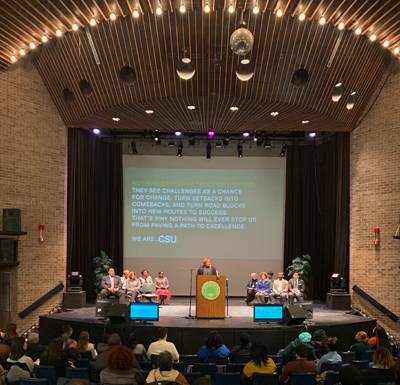
Thank you, Shana Miller, for that warm introduction.
I want to start by welcoming our board chair Andrea Zopp, and thank our faculty, staff, students and alumni for attending this afternoon.
As I enter my second year as President, it is my honor to give my second State of the University address. We are indeed living in one of the most consequential times in our history as a city, a state, and a nation. During this time, Chicago has experienced a record level of out-migration of its black population. Our city is struggling with the effects of segregation and unprecedented levels of wealth inequality.
For those on the disadvantaged side of the economic divide, the costs include poorer health and declining life expectancies, unwinding some of the great achievements of the 20th century, including those achievements in the area of civil rights.
We are also rapidly arriving at a place, where post-secondary education is not a nice to have. It’s becoming a requirement for anyone who hopes for a good career, and for any state that hopes to foster opportunity for all. The role of higher education and the role of Chicago State University could not be more important. Chicago State has a rich, 153-year history of providing education opportunities that dates back to the Reconstruction Era. The fact that we are a highly accessible university is important in that it allows us to innovate and educate in a way that brings important diversity to our city, our state and our nation. Because we have such an affordable tuition rate and because we now have the strong support of a new governor and the General Assembly, Chicago State is ready for the transformation taking place in the Illinois world of work—and is offering our students a path to high-skilled jobs and better lives in Illinois. A strong Chicago State will help stem the tide of outward migration from Illinois. Together, as a University community, we are harnessing our rich history, and harvesting the hopes and the dreams of our students and alumni to guide Illinois to a bright future.
Chicago State University is forever in motion
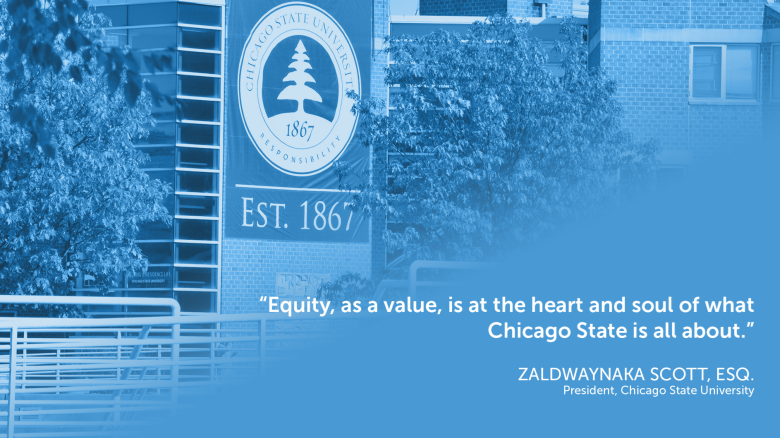
Our forward motion and momentum is centered around securing equity for our students. Equity is at the heart of what Chicago State does every day. It requires that we pay attention to the facts and the factors impacting college access and completion. For example, the number of African American students enrolled in Illinois public colleges and universities has fallen nearly 26 percent in recent years. This fact stands alongside of others that show a widening achievement gap between black students and every other ethnic group. Black students have higher drop-out rates and lower six-year completion rates according to the American Council on Education’s 2019 report on race and ethnicity in higher education.
Given this data, the work that Chicago State is doing to educate our students is more important than ever. Chicago State is Illinois’ only four-year U.S. Department of Education-designated predominately black Institution. We also have an incredibly diverse student population, with students of all ethnicities, and students from 36 states and 26 countries.
To support our work we have a world-class and diverse faculty. Among our faculty members we have award winners, prolific authors, researchers who work on groundbreaking projects in the sciences and humanities, and faculty who are leaders in community organizations. Chicago State is ranked first in Illinois and tied second nationwide among public universities for equity in educating and supporting African American students, according to a study by the University of Southern California’s Race and Equity Center. We are ranked second in the nation among HBCUs by a number of African American physics graduates each year by the American Physics Society. And our graduates are highly sought after; we have a 100 percent job placement rate for graduates in nursing, occupational therapy and pharmacy, as well as education.
While we are indeed moving forward, the administration and I recognize that there are current challenges being faced by some academic programs within the University. As a result, we are engaged in developing and implementing action plans to address these challenges. We are confident that these academic programs will successfully emerge, strengthened as a result of the action plans.
I want to speak for a minute on enrollment. We are growing! For the first time in 10 years, our enrollment has stabilized, and is up. The fall enrollment was up 3 percent and in spring, 1 percent. While these gains are modest, they are significant and signal a renewal. With this momentum, we are going to keep growing and pushing our University and students forward because a CSU degree has a proven value.
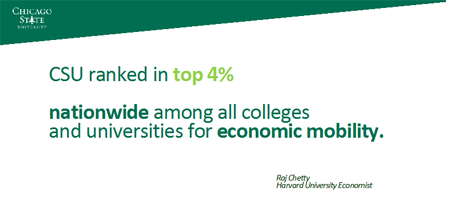
Recently, the New York Times reported on a study on higher education and social mobility conducted by Harvard University economist Raj Chetty. The study looked at student outcomes and measured the likelihood that a student from a low-income background is able to move up two or more income brackets. The study showed that graduates of Chicago State University were among the most likely to improve their economic status with a college degree. In ranking the nation’s best universities for economic mobility, CSU ranked number two out of 103 colleges and universities in Illinois, and in the top 4 percent nationwide out of over 2,000 colleges and universities. This study comes at a time when some question the value of a college degree.
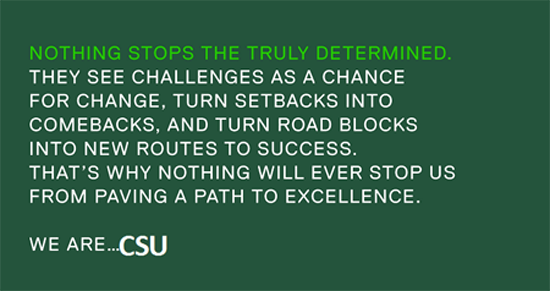
We are proud to not only provide our students with a well-rounded liberal arts education, but also to provide our students the tools they need to succeed financially once they graduate.
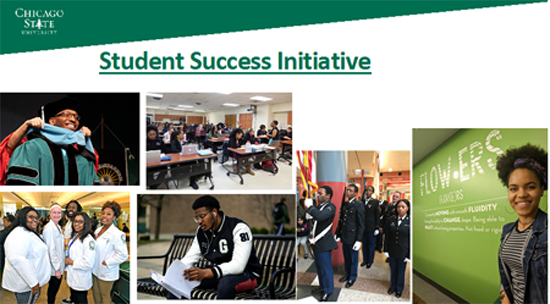
Over the last 18 months, we’ve been transforming and renewing our campus to better support our students. In the fall, we convened two student town halls to hear directly from our students. We are implementing changes to address the concerns that were raised because CSU is moving forward together.
Last year, I spoke to you about the Student Success Task Force. The task force was charged with understanding our challenges and opportunities around retention and graduation. Using what we’ve learned from the work of the task force, this year we’ve taken bold action to innovate Chicago State around student success. Bold action is necessary because of the data we have reviewed. My team at CSU has analyzed the enrollment data of our neighboring and feeder high schools on the Southeast Side of Chicago, and we have found that high school enrollment at these schools have dropped by 50 percent or more in just the last 10 years. These schools include those schools closest to CSU —Harlan Academy, Corliss and Julian High. Not only has general enrollment at these high schools plummeted, but the college-going and college-eligible student populations at our neighboring schools have also dropped over the past 10 years with one of the greatest populations drop citywide in the neighboring Roseland community. Roseland has seen over 14,000 residents leave its neighborhood.
These declines in population and high school enrollment also comes at a time when the number of African American students enrolled at public colleges and universities in Illinois has fallen nearly 26 percent in recent years as I mentioned earlier. This is a crisis for both our state and for Chicago that we must work together to address. That is why student success and college completion is my administration’s top priority for the University. We must work to enroll and retain CSU students.
Enrollment management’s part of student success is not simply the initial registration of students. Enrollment management includes helping our students successfully move through their first two years on our campus, a time period when they are most likely to drop out. It means we help our students re-enroll and plan their next academic year as early as possible, including the completion of the FAFSA. We cannot afford to be passive and hope students will come to CSU out of high school because there are from our surrounding neighborhoods. We have to demonstrate the value of a CSU degree to principals, counselors, families and students. We cannot afford to be passive and just think that our students who finish the spring semester will come back in the fall after having no contact with faculty members or our campus over the summer. We have to work to prevent summer melt by engaging with students year-round, through summer class offerings or internship programs.
Student success is why we are undergoing a dramatic transformation to center our University around improving our retention and graduation rates. We have developed and implemented a comprehensive set of student success initiatives, focused around five key access points:
- Pre-college and college readiness
- First-year success
- College persistence
- Holistic college support
- Career readiness
We know that our students are not all equally prepared for college, and that is a challenge to our mission of offering the broadest possible access to quality higher education. I want to highlight two student success initiatives: 1) RISE Academy and 2) the direct financial investment in student scholarships. The RISE Academy is a summer bridge program designed to provide new students with an early and supportive introduction to college. We conditionally admitted these students to the University. Over the summer, the students took a credit-bearing course and engaged in other cohort-building activities. We had an over 90 percent pass rate for the students and this success continued into the fall semester.
We’ve also made student scholarships a priority. We want to do what we can to ease our students’ financial struggles. This academic year, we have been able to provide more financial support for our students than ever before, with new financial aid programs and new scholarship offerings to complement our existing supports. In fall 2019 alone, we provided $3.6 million in financial aid directly from CSU, in the form of our own scholarships, waivers and book vouchers. That is on top of the $5 million in federal Pell and Illinois MAP grants. We have in place a microgrants program that automatically provides small financial awards to meet students’ needs when they have a gap in their financial aid packages. We provide Illinois AIM High scholarships to low- and middle-income students and offer scholarships for our Honors College. We have scholarships for our non-traditional students and our Adult Integrated Learning program. In the fall, we plan to offer scholarships among all five of our colleges, and for our DACA and international students. On top of all of this scholarship support, CSU offers in-state tuition rates for all students.
We are also transforming the residence hall into a living learning community. In the fall, we will initiate a Faculty-in-Residence program that will have a faculty member living in the dorm to serve as a formal and informal resource for the students living on campus. We will also bring two student tutors to live in the dorm. Living learning communities have been shown to improve student success rates, graduation rates and overall campus experience. We’re looking forward to making our residence hall a living learning community.
We are also focused on improving access to internships and other learning experiences for our students. With internship and apprenticeship programs, we help students connect the dots between their education and real-world opportunities. We have many more student success initiatives that we have implemented. No student should have to make the hard choice between attending college and feeding themselves. That is why we have opened a campus food pantry.
We know that students excel from a high-touch advising system. Therefore, we have created an intensive advising redesign. This is our effort to improve student success. That is why we worked for over a year building relationships with foundations, talking about student success, and what their support can mean for our students.
Our work to engage foundations has been supported and facilitated by the Chicago State Foundation and its executive director Darrious Hilmon. Darrious has continued to build a best-in-class board of directors for the Foundation who have each committed to a $5,000 contribution as part of their board service.
We are well on track to see a successful Foundation scholarship gala in May for which the Foundation has secured, not one, but two premier corporate sponsorships—Hyatt Corporation and Greely and Hansen—an environmental engineering firm specializing in water and wastewater engineering and utility management consulting.
Earlier this year, we were proud to receive a grant from an anonymous donor to fund our academic advising redesign, which will help our advising services become more robust and comprehensive.
CSU continues to innovate, including innovation in curriculum. I want to thank our faculty, who have been driving curriculum innovation. I want to take a moment to share that over the past two years, the CSU administration and faculty and staff represented by UPI Local 4100 have been in negotiations toward a new collective bargaining agreement. I am pleased to share that we reached a tentative agreement on February 7th on a new long-term contract that will give our hard-working faculty and staff a raise that respects the important work they do for our students and campus community.
Let’s continue our discussion about curriculum innovation. We launched our first MBA program through a Weekend MBA format, a program that will help our students gain access to corporate management opportunities. The MBA program design included input from leading corporate and non-profit partners to ensure we’re teaching the skills and curriculum students need. We welcomed our first MBA cohort this past fall.
We have a newly accredited Library Science Master’s Program that is one of only two programs in the country accredited by the American Library Association that serves a primarily African American student body.
We have also introduced an Adult Integrated Learning Program that allows adult learners and returning students to receive college credit for life and work experience. During this academic year, we will be opening an adult learning center to provide better access to returning and non-traditional students. The center will help adult learners navigate the entire college experience.
We’ve partnered with local high schools to provide dual enrollment opportunities to their students. Over 30 high school students completed classes in the fall, earning valuable college credit while participating in an on-campus learning experience. Research suggests that the time spent by high school students in the post-secondary classroom can lead to more college-going behavior. We have been engaging with our area high schools to reintroduce them to Chicago State. Provost Roundtree, the academic deans and I have personally gone to visit our CPS high schools. These visits have yielded amazing results that are already showing up in our applications for admission and relationships with the high schools. The high school visits will continue and will now include schools in the south suburbs.
We have also launched the Center for Innovation, which is designed to prepare the community for careers in the cannabis industry and provide potential cannabis-related research opportunities for our faculty. Legal marijuana is the fastest-growing industry in the nation. We sit in the neighborhoods that have been directly impacted by the War on Drugs, now our communities should benefit. Our faculty developed a curriculum and we now offer a five-course certificate to learn about the cannabis industry. The Center for Innovation is the forefront of curriculum innovation in cannabis. Western University has announced a minor concentration in cultivation. Oakton Community College has developed credit courses in the industry. Sixty-two percent of U.S. pharmacy schools have incorporated medical cannabis into their doctorate of pharmacy programs, and another 23 percent planned to incorporate it into their programs in the next 12 months.
For the first time in 10 years, our state government has made an investment in public infrastructure. We know that we have significant campus infrastructure needs. Along with Provost Roundtree, VP Holmes, faculty members and the deans, I have been in the science labs, the greenhouse and the classrooms. Many of our buildings have systems that are in serious need of repair. In some instances, we could not wait for the state, so we took upon many of these projects ourselves with our operating dollars. That is why we advocated for and received from the state $34 million in new capital funds. This will allow us to make much needed infrastructure improvements on campus. One of our biggest capital projects will be the development of a new health professions simulation lab. The governor was here in November to announce that they released some of the funding for it.
We’re delighted to have been able to hire 15 new faculty members, who will bring their expertise and abilities to our campus. Our faculty, staff and students continue to receive recognition for their talents locally, regionally and internationally. Since August, our faculty published over 30 publications, made 17 presentations and four grant submissions.
These accomplishments demonstrate that we are forever in motion
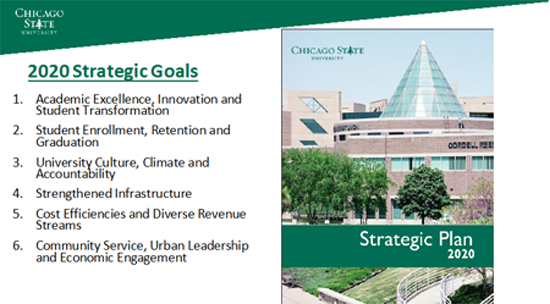
I want to thank everyone for their hard work and dedication to ensuring the brightest possible future for Chicago State through work on our strategic plan that was passed by our board in December 2019. The Strategic Planning Committee was comprised of faculty, staff and students who have volunteered to help shape how the University will move forward. In our plan, we have reaffirmed our mission and our values. The plan sets forth six goals for the University.
Our mission is to transform students’ lives by innovative teaching, research and community partnerships through excellence in ethical leadership, cultural enhancement, economic development and justice. Answering this mission means making choices every day that reflect our values, as well as helping our students to develop their own values. This mission can’t be implemented without all of us working together. That’s why one of our strategic goals focuses exclusively on University culture, climate and accountability. It’s about how we work together; how we treat each other and our students. How do we support each other? We want to “create, communicate and sustain an inclusive and welcoming University climate that fosters an institution that is ethically and socially responsible.” We have to continue to build a culture that supports each other and that is focused on serving our students. We will live that culture by how we treat each other and the students we serve, and how we talk about Chicago State to the world.
You’ve heard all of the things we’ve accomplished as a University—we are transforming through our work, and we decided to reflect that transformation in how we present ourselves to the public. What do I mean?
We were fortunate to have the team of creative and media experts from Leo Burnett, Spark Foundry and Russell Williams Group come in and learn from our students, faculty and staff about Chicago State. From this work the companies have created a new University brand identity and tagline to reflect the forward-moving direction of Chicago State. The new brand also represents our commitment to innovation while honoring our 153 years in higher education. Other changes include a new tagline and the addition of two new complimentary colors to our evergreen and white color palette. The brand redesign was introduced to our board of trustees by company executives during our board meeting on February 10. The corporate team was led by two award-winning advertising executives, Spark Foundry’s ET Franklin and Leo Burnett’s Renetta McCann. The value of the pro bono service is approximately a half million dollars.
We will be revealing our new brand to the world in the coming months during a formal brand launch reception.
I began this speech by considering where we are as a city, a state and a nation at this point in history and by discussing the rich and influential history of Chicago State University. It is clear that our public university system and particularly Chicago State is important to our state. We know that education can open doors to those trapped by economic and social forces often dictated by a simple zip code. Education gives our students the power to shape their own lives and the skills to renew our communities.
We are committed to equity in higher education. I am incredibly proud of the progress we’ve made, and I’m eager to continuing to move forward together.
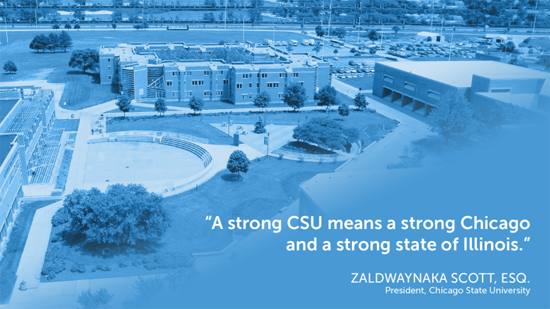

 All Rights Reserved
All Rights Reserved